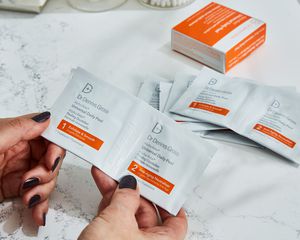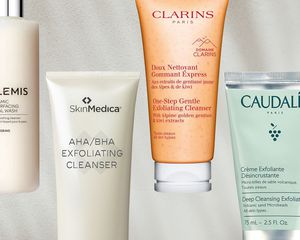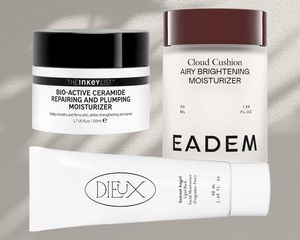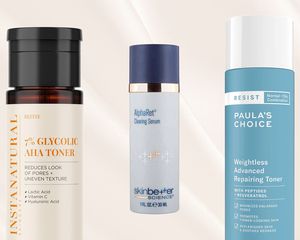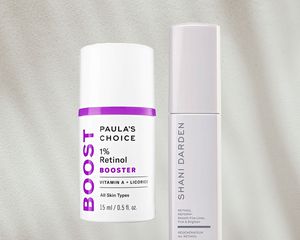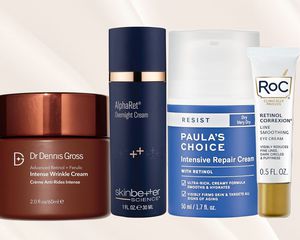:max_bytes(150000):strip_icc()/How-to-fix-uneven-skin-texture-4686864_800x1000-70305493e6a04c98a37b7e32ada256c6.jpg)
PLUME CREATIVE/ GETTY IMAGES / Design by Michela Buttignol
If you're human, you have skin texture. It's the natural byproduct of having skin to begin with. Pores, scars, bumps, and bruises are all part of the human experience, but they don't have to detract us from living life to the fullest. If dull, uneven skin texture has you yearning to cover up and hide, we're all for discovering methods to soften and smooth our way to the glowiest version of ourselves possible. The first step? Arm ourselves with knowledge and understanding what exactly causes uneven skin texture.
"Uneven skin texture is commonly a result of excess dead skin cells that build up on the surface of the skin. This can make areas of the skin feel rough or bumpy to the touch and can also give the skin a dull appearance," explains board-certified cosmetic dermatologist Paul Jarrod Frank, MD. "In addition to dead-skin-cell buildup, chronic sun exposure can also play a big role in uneven skin texture and pore-size irregularity. Natural aging of the skin will also make the skin look duller. Factors such as smoking may also contribute, and other skin conditions such as eczema and dry skin can severely affect skin tone and texture."
Wondering how to nurture your skin to looking and feeling its best? Below, Frank and Dr. Brendan Camp, double board-certified dermatologist, break down how we can reduce texture and smooth skin for the silkiest glow-up of all.
Meet the Expert
- Paul Jarrod Frank, MD, is a board-certified cosmetic dermatologist based in New York City. He is the author of The Pro-Aging Playbook and creator of the Pro-Aging Podcast.
- Brendan Camp, MD, is a double-board-certified dermatologist at MDCS: Medical Dermatology & Cosmetic Surgery.
Get to the Source
No remedy can be truly effective if the problem persists. Treating uneven skin texture can become an exhausting (and expensive) cycle if you're only addressing the symptoms of a larger culprit. Assess your current skin concerns and try to find the underlying cause. If acne scarring and hyperpigmentation are your main distress, perhaps it's time to seek professional help in ameliorating the source of the acne itself. If eczema or dry, irritated skin are creating texture, there could be a microbiome disruption, sensitizing ingredients in household products, or even an environmental imbalance that's causing the flareups.
Treat Acne Before It Forms
"Acne can cause fine irregularities (comedones) or more pronounced undulations (papules, cysts)," explains Camp. It can also leave behind scarring and indentations long after the pimples have dried. If acne is at the root of your texture concerns, the best course of action is to stop it before it forms and treat it if does. "Acne can be treated with over-the-counter medications, like salicylic acid, benzoyl peroxide, and retinoids like adapalene," says Camp. "Salicylic acts as a gentle exfoliant, benzoyl peroxide has keratolytic properties to help remove dead skin cells, and adapalene helps to regular cell turnover to help prevent the formation of comedones."
Invest in a Humidifier
"Texture changes on the skin can be caused by a number of things. Dryness can make the skin feel coarse and rough," says Camp. "Skin dryness can simply be from dry skin, or the result of an underlying condition, like seborrheic dermatitis, eczema, or the reaction to a topical treatment." If your dry skin is the result of external factors such as the climate, dropping temperatures, or low humidity, Camp suggests using a humidifier to add moisture to the air.
:max_bytes(150000):strip_icc()/How-to-fix-uneven-skin-texture-4686864_final_rev2-8d346149b78b4f5c8d0393cd4fe10add.png)
Exfoliate to Smooth
If skin-cell buildup is the issue, remedying the situation could be as simple as sloughing those dead cells away. Make sure you're exfoliating twice a week and target the areas that feel uneven. Camp recommends reaching for either a lactic or salicylic acid formula. "Lactic acid is an alpha-hydroxy acid that acts as a gentle skin exfoliant. Salicylic acid helps unclog pores of excess oil and gently remove dead cells, leaving skin looking brighter, younger, and feeling smoother," he adds.
Approach Physical Exfoliants With Caution
All that being said, it's worth noting that physical exfoliation products that are too abrasive—or using them too often, for that matter—can cause oil overproduction and skin damage, which will only exacerbate your texture issues. Stick with formulas that use spherical particles (no jagged edges), and make sure you abide by that twice-a-week rule. "Dehydrated milk powder can be used as a physical exfoliant to facilitate the removal of dead cells from the skin surface," says Camp.
The alternative is to ditch scrubs altogether in favor of chemical exfoliants, a gentler option that allows for more consistent results.
Use a Vitamin C Serum
One key ingredient for evening out skin tone also works to smooth out uneven texture. Vitamin C is a powerful antioxidant that delivers a double whammy of repair and defense against environmental damage. That defense is key if you want to avoid more texture problems down the line and the restorative properties can return suppleness to the skin while reducing pigmentation, scar tissue, and age spots.
Always Wear SPF
As Frank explained, sun exposure can cause uneven skin texture and pore size. Camp adds that sun damage "can contribute to skin wrinkling and the formation of precancerous growths called actinic keratoses, which are rough and gritty in texture." So taking the proper precautions to protect your skin with a minimum of SPF 30 will prevent further damage. Add this to the endless laundry list of reasons that protecting your skin from the sun should always be your first priority.
Address Your Existing Scars
Part of tackling uneven skin texture is maintenance. Whether you have a new or existing scar, it's important to diminish its appearance—especially those pesky ones that have a raised, discolored texture. Patience is key here, and you have to be diligent to see results. Use a product that is geared toward scar treatment, follow the directions carefully, and you'll likely notice an improvement over the next few months.
The ability to heal or diminish the appearance of scars, however, largely depends on the severity of the scarring. Deeper scars may require a bit more firepower than topical products can provide. "Scarring often requires the use of an in-office energy-based device. Microneedling, laser, and filler are examples of in-office treatments used to treat scarring," explains Camp.
Add Retinol to Your Skincare Routine
Many dermatologists agree that retinol may be the best treatment option for uneven skin texture. The vitamin A derivatives are skincare powerhouses for promoting collagen and increasing epidermal turnover, meaning they can improve the skin's texture and tone as well as lighten leftover hyperpigmentation. "Retinols are effective treatments for fine lines, wrinkles, dark spots, and uneven texture," Camp says.
Ask Your Dermatologist About Retinoids
Retinoids are a type of chemical exfoliant that help increase cell turnover, thus sloughing off texture and revealing baby-smooth skin. (The difference between retinoids and retinol is that retinoids are a family of vitamin A derivatives that include retinol and other prescription-strength alternatives, while retinol is a specific ingredient). And while retinoids like retinol are easily found in most over-the-counter products, prescription-strength retinoids like tretinoin will require a prescription (and are typically more efficacious)."Prescription retinoids tend to be stronger and more effective than over-the-counter retinols," explains Camp. "This is because they require fewer metabolic steps to reach their active state."
Try a Chemical Peel
As you get older, your body has a harder time than it once did shedding dead skin cells. When your skin hangs onto those dead skin cells, you're left with a dull, uneven tone and, yep, uneven texture, too. One easy and effective way to quickly shed the top layer of skin is with a chemical peel. There are many different types and strengths depending on the results you want and your skin type, so when it comes to a chemical peel, schedule an in-office treatment and leave it in the hands of a professional to prevent any mishaps or accidental chemical burns. "In-office treatments like chemical peels and ablative laser treatments help improve texture and improve collagen production to improve skin tightness and quality," says Camp.
If you don't have the time (or the funds) to get a peel at your dermatologist's office, use an at-home mask to do the trick. Look for an option that is gentle and nonabrasive to prevent the chance of damaging your skin.
Get a Microneedling Treatment
Microneedling is a favorite among beauty editors because of its quick and noticeable results for scarring and general uneven texture. Just like the name says, the process requires the use of small needles to create tiny punctures in the skin. These micro-injuries cause your skin to go into repair mode, which increases its collagen production and reduces the appearance of pores, acne scars, and fine lines for a smoother texture overall.
Consider Laser Resurfacing
Frank notes that those who deal with chronic texture issues will see the best results with laser treatments—but these tend to be the most aggressive and expensive. Similar to microneedling, laser treatments produce results by creating tiny wounds to the skin in order to activate wound-healing pathways. Once activated, the body's natural healing process will repair not only the new wounds but can minimize the appearance of scars, lighten hyperpigmentation, remove sun damage, reduce fine lines and wrinkles, and tighten loose skin.
Seek Professional Help
While some of the above in-office treatments will likely put you in the hands of a seasoned pro, it's important to know when over-the-counter products and at-home remedies just don't cut it. "If at-home attempts do not resolve texture changes, seek the assistance of a board-certified dermatologist for evaluation and treatment," advises Camp.

